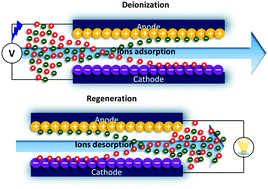New testing procedures of a capacitive deionization reactor
Abstract
Currently, according to conventional charge–discharge profiles, energy consumed in charging Capacitive

* Corresponding authors
a
Electrochemical Processes Unit, IMDEA Energy Institute, Ave. Ramón de la Sagra 3, Mostoles Technology Park E28935, Mostoles, Spain
E-mail:
enrique.garcia@imdea.org
Fax: +34 917 371 140
Tel: +34 917 371 132
b
Environmental Chemistry & Technology Program, University of Wisconsin-Madison, WI, USA
E-mail:
nanopor@wisc.edu
Fax: +1-6082620454
Tel: +1-608-2622674
Currently, according to conventional charge–discharge profiles, energy consumed in charging Capacitive

 Please wait while we load your content...
Something went wrong. Try again?
Please wait while we load your content...
Something went wrong. Try again?
E. García-Quismondo, R. Gómez, F. Vaquero, A. L. Cudero, J. Palma and M. Anderson, Phys. Chem. Chem. Phys., 2013, 15, 7648 DOI: 10.1039/C3CP50514F
To request permission to reproduce material from this article, please go to the Copyright Clearance Center request page.
If you are an author contributing to an RSC publication, you do not need to request permission provided correct acknowledgement is given.
If you are the author of this article, you do not need to request permission to reproduce figures and diagrams provided correct acknowledgement is given. If you want to reproduce the whole article in a third-party publication (excluding your thesis/dissertation for which permission is not required) please go to the Copyright Clearance Center request page.
Read more about how to correctly acknowledge RSC content.
 Fetching data from CrossRef.
Fetching data from CrossRef.
This may take some time to load.
Loading related content
